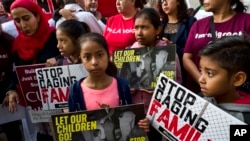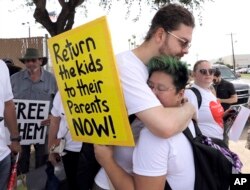The Trump administration hit a court-ordered deadline Tuesday to return immigrant children under the age of 5 to their parents, forcing the government to roll back many of the family separations that resulted from its “zero-tolerance” border enforcement policy.
Last month, U.S. District Judge Dana Sabraw gave authorities 14 days to reunite parents with children under 5, and 30 days to reunite parents with all other children.
Here are some answers to questions about how the process will work and some potential problems ahead:
How many children are separated?
At least 2,000, according to estimates issued last month by the Department of Health and Human Services, which shelters immigrant minors under federal law.
On Thursday, HHS Secretary Alex Azar told reporters that the number was “under 3,000.” That raised questions about whether the number had risen.
At least 34 children were to be reunited with parents Tuesday, the HHS said. That’s less than half of the number of children under 5 the Trump administration says are covered by the court order.
The Justice Department said more than 50 separated children could be back in the arms of their parents by the end of the day.
The exact number of reunions will depend on whether authorities can confirm the parents’ identities. Authorities gave few details on where the reunions would be held, and many were expected to take place in private.
Some families will miss the deadline. The administration says some of those parents have been deported, and eight have been previously released in the United States.
What does the process involve?
The parents who were expected to get their children back Tuesday were being moved to detention facilities close to the shelters where their children are, Justice Department lawyer Sarah Fabian said.
HHS has conducted DNA testing to confirm that the adults and children are related. The government is also doing criminal background checks on parents and potential sponsors.
There are significant disagreements between the government and the ACLU over the process, including whether DNA testing is necessary. The government says it should be the general rule, and the ACLU says it should be done only when no other evidence is available to prove parentage.
What are family members doing to get their kids back?
A handful of parents have gone to court. They include a Congolese woman who was separated from her 7-year-old daughter after they sought asylum in California. The ACLU sued on her behalf and expanded its lawsuit to broadly include parents separated from their children.
Many adults bring records with them to prove parentage to government agencies.
The government and the ACLU jointly filed a form late Monday that would be read to all parents in detention without their children. The notice says that a parent separated from his or her child “should not be pressured to agree to removal” from the U.S. to be reunited.
The notice also says that parents who are going to be deported can decide beforehand whether to ask for their child to go with them.
Why is it taking so long?
At the time that Sabraw set the 30-day deadline to reunite all separated parents and children, HHS said children in its care were spending an average of 57 days in a shelter.
Former officials in the HHS Office of Refugee Resettlement say its system is accustomed to serving teenagers who arrive in the U.S. alone, often knowing the name of a relative who could potentially sponsor them. Now, some children in the system are too young to talk or struggle to answer questions.
The process also relies on coordination between HHS, which shelters children, and the Department of Homeland Security, which detains adults and initially separated parents and children. HHS says its case managers are working with ICE to link families.
But HHS acknowledges it’s working with “disparate data sets.” Azar has had to order an audit by hand of all records to confirm which children in his department's care have been separated from a parent.
Twelve parents with children under 5 have been deported already, according to the government.
That leaves the cases of children such as 1-year-old Johan, who appeared in immigration court last week , nursing from a bottle. His father has been deported to Honduras.
The legal group representing the boy said Monday that Johan took his first steps in a government shelter two weeks ago.








